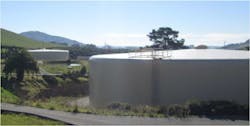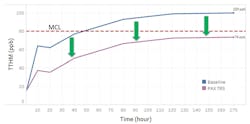For the city’s water utility operators, however, the business of supplying high quality water to the community and surrounding areas is anything but slow. The 16 million-gallon-per day (MGD) water treatment plant utilizes advanced treatment techniques such as primary disinfection with ozone and ballasted-flocculation in addition to traditional filtration. The city distribution system includes over 150 miles of distribution piping that the utility staff is intent on improving through a set of continuous pipeline replacement projects. City crews employ an additional number of operational tactics to maintain water quality such as flushing programs and systematic valve exercising.
The San Luis Obispo Water Treatment Plant receives water from three different reservoirs, which can result in varying levels of naturally occurring organic material (NOM) in the feedwater. While the primary water disinfection is done with ozone, secondary disinfection employs free chlorine, which can react with NOM to create disinfection byproducts such as trihalomethanes (THMs). As water age increases (the time from water treatment in a plant to ultimate use), THM formation progresses and water utility operators closely monitor their system’s running THM average against the violation level of 80 parts-per-billion (ppb) set by the Environmental Protection Agency. In 2014 and 2015, the city experienced THM levels that caused concern and staff began to investigate processes and practices that could head-off these high THM recurrences.
THMs can be removed by a process known as air-stripping as they are volatile compounds — meaning that they can be readily moved from the water (liquid phase) into air (gas phase) with the application of carefully calculated mixing energy and adequate tank-headspace ventilation. UGSI Solutions studied the 2015-2019 dataset of THM levels in water storage tanks as well as at the compliance points in the network. From that dataset and actual THM formation testing, the team derived the actual THM formation curve for the entire system, which could be used to model a solution (see Fig. 1).
In reviewing options to remove THM species that included bromodichloromethane and chloroform, UGSI engineers and city staff concluded that aeration as a THM mitigation step would be the best course of action. An ideal location for this equipment would be in the city’s Clearwell #2, which was a 2-million-gallon tank with very short detention times (including regular flow rates of up to 5 MGD). Typically, extended water detention times in tanks aid in THM removal as aeration of the volatile THMs can take place over a longer period. City officials selected Clearwell #2 because of its location. It was quite early in the distribution network and if THMs could be lowered significantly in that tank, the entire THM formation curve for the system could be shifted downward (see Fig. 2).
The PAX TRS system design was comprised of seven powerful 15 HP surface aerators, a 12,000 CFM Powervent® headspace ventilation unit and a PAX PWM-500 tank mixer. In addition, UGSI Solutions would warranty a minimum of 40 percent THM removal.
“The PAX TRS system exceeded the original THM removal expectation and as a result, we have a much greater degree of THM control in our water system,” Jason Meeks, San Luis Obispo water treatment supervisor, said.
Installation was completed at the end of 2019, with system validation accomplished in May 2020. As is typical of THM removal tests, the system validation occurred over a 14-day period to allow for the system to reach equilibrium in THM formation and removal. The PAX TRS™ THM removal system exceeded the designed 40 percent THM removal and reached over 50 percent THM removal (see Fig. 3). WW
About the Author: Andrew D. Seidel is the chief executive officer and chairman of UGSI Solutions Inc., a process technology company specializing in chemical feed and disinfection. He has recently served as a director on the Boards of O’Brien & Gere, a private engineering services company located in Syracuse, N.Y., and Ostara Nutrient Recovery Technologies Inc., a resource recovery company located in Vancouver, Canada. Seidel was a founder of and the CEO of Underground Solutions Inc., which was sold to Aegion in 2016. Seidel was a founder of and served as the CEO of United States Filter Corporation (USFilter) from 2000 to 2004 after serving in multiple senior management positions. He has served on the boards of Aqua America, Veolia Environment, Nuverra Environment Solutions, and National Waterworks (predecessor of Core & Main). He holds a B.S.E. degree in chemical engineering and an M.B.A. from the Wharton School at the University of Pennsylvania. In 2017, he was awarded the D. Robert Yarnell award from the University of Pennsylvania School of Engineering and Applied Science.
About the Author
Andrew Seidel
Andrew Seidel is the Chief Executive Officer and Chairman of UGSI Solutions, Inc., a process technology company specializing in chemical feed and disinfection. He has recently served as a Director on the Boards of O’Brien & Gere, a private engineering services company located in Syracuse, NY and Ostara Nutrient Recovery Technologies, Inc. a resource recovery company located in Vancouver, Canada.



